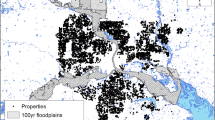Abstract
This study estimated the effect of flood hazards on residential property values by applying a hedonic price model to house sale data from 2007 to 2013 in the Fargo-Moorhead Metropolitan Statistical Area. A difference-in-difference framework was used to estimate changes in the price discount associated with houses located within a 100-year floodplain. We investigated how this price discount changed following a major flood event, providing empirical insight into how flood risk was perceived by homebuyers. We also estimated how the price discount varied as the control group was composed of houses increasingly further from the 100-year floodplain. Our results suggest that the flood price discount varies both temporally and spatially. Particularly in the year following a major and non-major flood event, the price discount increased by over 13%. Additionally, the estimated price discount when comparing properties inside the floodplain to those 1000–1500 ft from the floodplain was 8.6 percentage points higher (in absolute value) than the estimated price discount when comparing properties inside the floodplain to those immediately outside the 100-year floodplain.




Similar content being viewed by others
Notes
Preferences for avoiding the inconvenience of flooding is likely to also factor in and may suggest some additional flood price discounts beyond the cost of insurance premiums, but the rarity of flooding is likely to make this a small factor relative to the annual cost of insurance.
The assignment to different rings is based on the distance to the nearest floodplain. For example, if a house is located in Ring 1 for floodplain area A, and Ring 2 for floodplain area B, the house will be assigned to Ring 1.
ESRI ArcMap 10.1 was used to conduct this task.
To implement the test procedure, we first began with the standard LM-Error and LM-Lag test. The LM-Error test statistic was 567.84 (P < 0.001) and the LM-Lag test statistic was 348.81 (p < 0.001); thus, both were statistically significant. Next, we moved on to Robust LM-Error and LM-Lag tests. The Robust LM-Error test statistic was 345.99 (p < 0.001) and the Robust LM-Lag statistic was 126.96 (p < 0.001). We selected the model with the largest LM statistic, which was the spatial error model.
We conduct Chi-square tests to examine if the shadow prices for housing and neighborhood characteristics are constant between treatment and control. Results indicate that the shadow prices are constant.
Correlations between the residuals and elapsed time for Models 4.1–4.4 are −0.0051, 0.002, 0.0212, and 0.0014, separately.
We assume that 20% of the home value is the land value, thus the insurance premiums are calculated based on a home value of $144,000.
References
Anselin, L. (2005), Exploring spatial data with GeoDa: A workbook. http://geodacenter.asu.edu/system/files/geodaworkbook.pdf
Atreya, A., Ferreira, S., & Kriesel, W. (2013). Forgetting the flood? An analysis of the flood risk discount over time. Land Economics, 89(4), 577–596.
Bin, O., & Landry, C. E. (2013). Changes in implicit flood risk premiums: Empirical evidence from the housing market. Journal of Environmental Economics and Management, 65(3), 361–376.
Bin, O., & Polasky, S. (2004). Effects of flood hazards on property values: Evidence before and after hurricane Floyd. Land Economics, 80(4), 490–500.
Bin, O., Kruse, J. B., & Landry, C. E. (2008). Flood hazards, insurance rates, and amenities: Evidence from the coastal housing market. Journal of Risk and Insurance, 75(1), 63–82.
Camerer, C. F., & Kunreuther, H. (1989). Decision processes for low probability events: Policy implications. Journal of Policy Analysis and Management, 8(4), 565–592.
Carbone, J. C., Daniel, G. H., & Smith, V. K. (2006). Can natural experiments measure behavioral responses to environmental risks? Environmental and Resource Economics, 33(3), 273–297.
Gilovich, T., Griffin, D., & Kahneman, D. (2002). Heuristics and biases: The psychology of intuitive judgment. Cambridge University Press.
Goodman, J. L. J. (1993). A housing market matching model of the seasonality in geographic mobility. Journal of Real Estate Research 8(1), 117.
Harrison, D. M., Smersh, G. T., & Schwartz Jr., A. L. (2001). Environmental determinants of housing prices: The impact of flood zone status. The Journal of Real Estate Research, 21(1), 3–20.
Kahneman, D., & Tversky, A. (1979). Prospect theory: An analysis of decision under risk. Econometrica, 47(2), 263–292.
Kousky, C. (2010). Learning from extreme events: Risk perceptions after the flood. Land Economics, 86(3), 395–422.
MacDonald, D. N., Murdoch, J. C., & White, H. L. (1987). Uncertain hazards, insurance, and consumer choice: Evidence from housing markets. Land Economics, 63, 361–371.
MacDonald, D., White, H., Taube, P., & Huth, W. (1990). Flood hazard pricing and insurance premium differentials: Evidence from the housing market. Journal of Risk and Insurance, 57, 654–663.
Morgan, A. (2007). The impact of hurricane Ivan on expected flood losses, perceived flood risk, and Property Values. Journal of Housing Research, 16(1), 47–60.
Rosen, S. (1974). Hedonic prices and implicit markets: Product differentiation in perfect competition. Journal of Political Economy, 72, 34–55.
Shilling, J. D., Benjamin, J. D., & Sirmans, C. F. (1985). Adjusting comparable sales for floodplain location. The Appraisal Journal, 53, 429–436.
Shultz, S. D., & Fridgen, P. M. (2001). Floodplains and housing values: Implications for flood mitigation projects. Journal of the American Water Resources Association, 37(3), 595–603.
Stull, W. (1975). Community environment, zoning, and the market value of single-family homes. The Journal of Law & Economics, 18(2), 535–557.
Zhang, L. (2016). Flood hazards impact on neighborhood house prices: A spatial quantile regression analysis. Regional Science and Urban Economics, 60, 12–19.
Acknowledgements
We would like to thank Fargo-Moorhead Association of Realtors for providing the real estate transaction data. We also gratefully thank the anonymous reviewers for the helpful comments. All remaining errors are our own.
Author information
Authors and Affiliations
Corresponding author
Rights and permissions
About this article
Cite this article
Zhang, L., Leonard, T. Flood Hazards Impact on Neighborhood House Prices. J Real Estate Finan Econ 58, 656–674 (2019). https://doi.org/10.1007/s11146-018-9664-1
Published:
Issue Date:
DOI: https://doi.org/10.1007/s11146-018-9664-1





